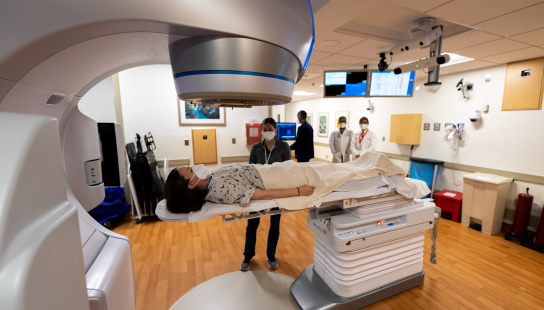
Stereotactic Radiosurgery

Stereotactic radiosurgery, or SRS, is an advanced form of external beam radiation therapy used for small targets.
SRS focuses beams of high-dose radiation in the shape of your tumor or specific area. The radiation is given in one large dose compared to multiple daily treatments.
SRS can treat conditions like cancerous and noncancerous brain tumors, skull-base tumors and tangles of blood vessels in the brain, called arteriovenous malformations (AVM).
Why We Use Stereotactic Radiosurgery
Radiation oncology specialists at University of Maryland have successfully used SRS since 1992. SRS is ideal for treating tumors near sensitive areas of the body such as the brain and spine. Patients who may benefit from stereotactic radiosurgery include those with:
- Brain tumors that can't be operated on because of location, type or size
- Metastatic brain tumors, which is cancer that has spread from another part of the body
- Primary brain tumors, which form in the brain
- Tumors not entirely removed by surgery
- Tumors that return after surgery or radiation treatment
- AVM
- Trigeminal neuralgia
You may also have stereotactic radiosurgery after whole-brain radiation therapy for metastatic tumors affecting the entire brain.
Frame-Based or Frameless SRS
Depending on your condition, you may have a frame-based or frameless SRS procedure.
- Frame-based SRS (Gamma Knife) uses a frame to immobilize your head during imaging, treatment and the time between.
- Frameless SRS (Edge Linac) uses a form fitting custom-made mask along with an on-board CT scanner and optical monitoring system to ensure your proper alignment.
Make an Appointment
To make an appointment at UM Greenebaum Comprehensive Cancer Center in Baltimore, call 410-328-6080. Or, contact one of our other five radiation oncology locations in Central Maryland, Eastern Maryland and Prince George's County.



